The Cambridge History of China. Vol. 13: Republican China 1912-1949, Part 2
Подождите немного. Документ загружается.

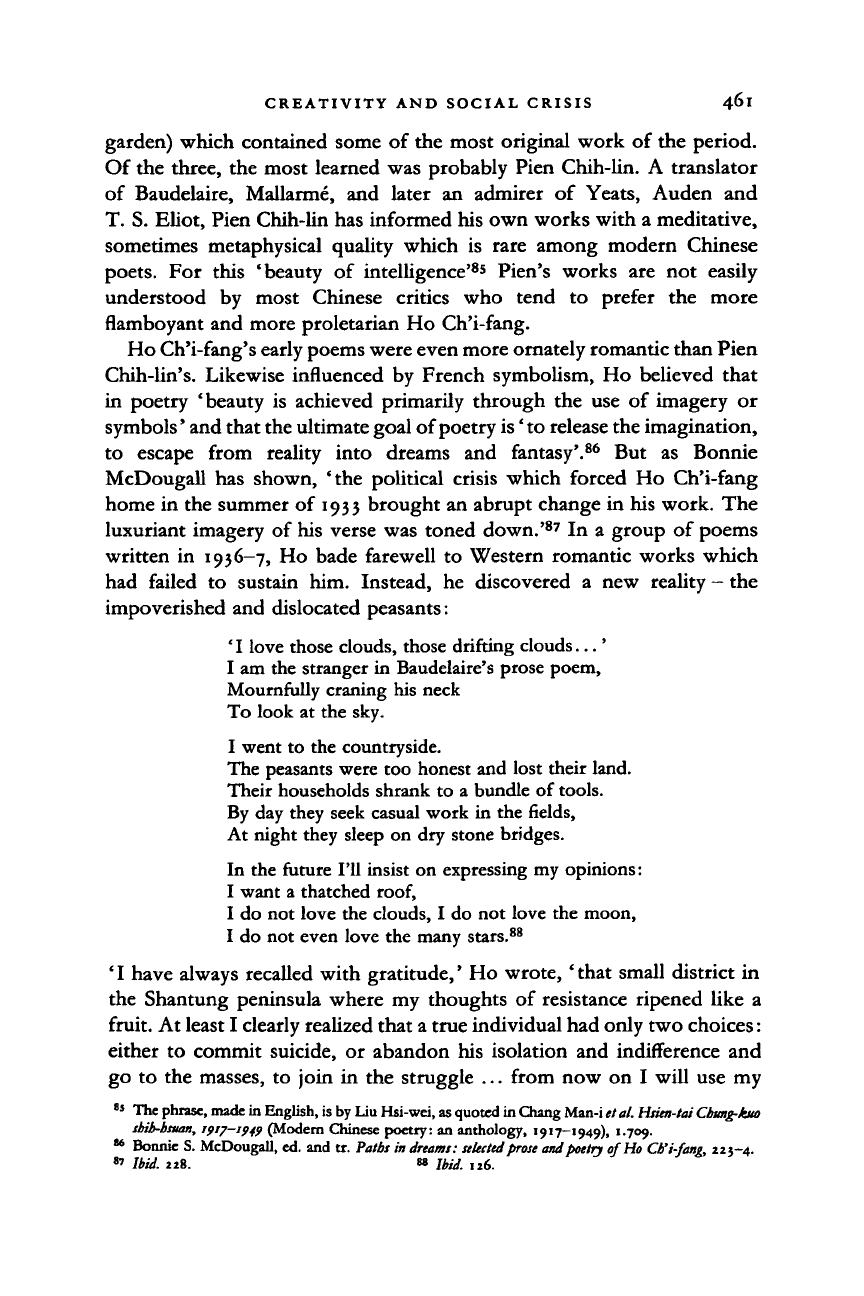
CREATIVITY AND SOCIAL CRISIS 4^1
garden) which contained some
of
the most original work
of
the period.
Of the three, the most learned was probably Pien Chih-lin.
A
translator
of Baudelaire, Mallarme,
and
later
an
admirer
of
Yeats, Auden
and
T. S. Eliot, Pien Chih-lin has informed his own works with a meditative,
sometimes metaphysical quality which
is
rare among modern Chinese
poets.
For
this 'beauty
of
intelligence'
85
Pien's works
are not
easily
understood
by
most Chinese critics
who
tend
to
prefer
the
more
flamboyant and more proletarian Ho Ch'i-fang.
Ho Ch'i-fang's early poems were even more ornately romantic than Pien
Chih-lin's. Likewise influenced
by
French symbolism, Ho believed that
in poetry 'beauty
is
achieved primarily through the use
of
imagery
or
symbols' and that the ultimate goal of poetry
is'
to release the imagination,
to escape from reality into dreams
and
fantasy'.
86
But as
Bonnie
McDougall has shown, 'the political crisis which forced Ho Ch'i-fang
home in the summer
of
1933 brought an abrupt change in his work. The
luxuriant imagery
of
his verse was toned down.'
87
In a
group
of
poems
written
in
1936-7, Ho bade farewell
to
Western romantic works which
had failed
to
sustain him. Instead,
he
discovered
a
new reality
-
the
impoverished and dislocated peasants:
' I love those clouds, those drifting clouds...'
I am the stranger in Baudelaire's prose poem,
Mournfully craning his neck
To look at the sky.
I went to the countryside.
The peasants were too honest and lost their land.
Their households shrank to a bundle of tools.
By day they seek casual work in the fields,
At night they sleep on dry stone bridges.
In the future I'll insist on expressing my opinions:
I want a thatched
roof,
I do not love the clouds,
I
do not love the moon,
I do not even love the many stars.
88
'
I
have always recalled with gratitude,' Ho wrote, ' that small district
in
the Shantung peninsula where my thoughts
of
resistance ripened like
a
fruit. At least I clearly realized that a true individual had only two choices:
either
to
commit suicide,
or
abandon his isolation and indifference and
go
to
the masses,
to
join
in
the struggle
...
from now
on I
will use my
85
The phrase, made
in
English,
is by
Liu Hsi-wei, as quoted
in
Chang Man-i et al. Hsien-tai Cbung-kuo
sbib-bsuan, ifij-ifjy (Modern Chinese poetry:
an
anthology, 1917-1949), 1.709.
86
Bonnie
S.
McDougall, ed.
and tr.
Paths in dreams: selected prose and poetry of Ho Clfi-fang, 225-4.
«'
Ibid.
228.
M
Ibid.
126.
Cambridge Histories Online © Cambridge University Press, 2008
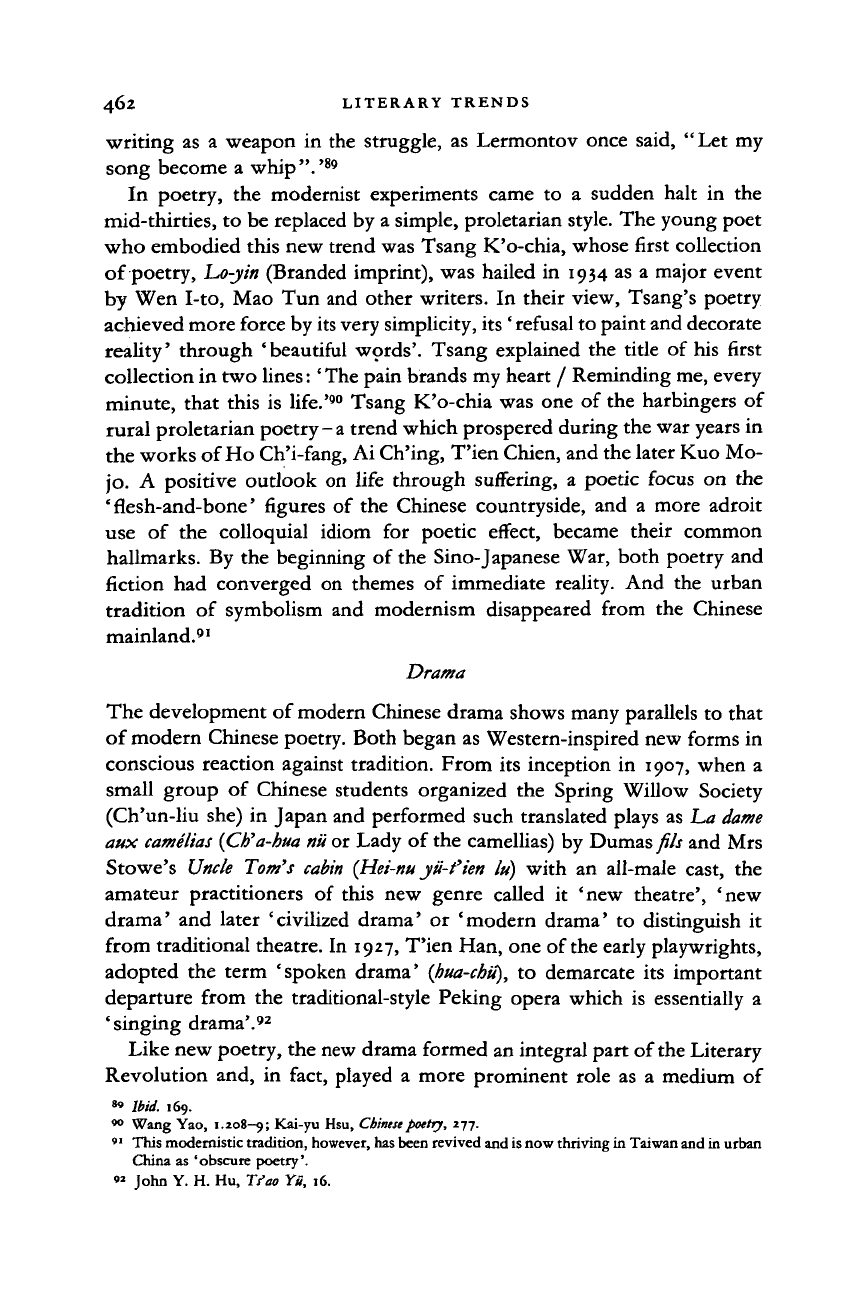
462 LITERARY TRENDS
writing as
a
weapon in the struggle, as Lermontov once said, "Let my
song become a whip
".
'
89
In poetry, the modernist experiments came
to a
sudden halt
in the
mid-thirties, to be replaced by a simple, proletarian style. The young poet
who embodied this new trend was Tsang K'o-chia, whose first collection
of poetry, Lo-jin (Branded imprint), was hailed in 1934 as
a
major event
by Wen I-to, Mao Tun and other writers.
In
their view, Tsang's poetry
achieved more force by its very simplicity, its ' refusal to paint and decorate
reality' through 'beautiful words'. Tsang explained the title
of
his first
collection in two lines:'
The
pain brands my heart
/
Reminding me, every
minute, that this
is
life.'
90
Tsang K'o-chia was one of the harbingers of
rural proletarian poetry-a trend which prospered during the war years in
the works of Ho Ch'i-fang, Ai Ch'ing, T'ien Chien, and the later Kuo Mo-
jo.
A
positive outlook on life through suffering,
a
poetic focus on the
' flesh-and-bone' figures
of
the Chinese countryside, and
a
more adroit
use
of
the colloquial idiom
for
poetic effect, became their common
hallmarks. By the beginning of the Sino-Japanese War, both poetry and
fiction had converged
on
themes
of
immediate reality. And the urban
tradition
of
symbolism and modernism disappeared from the Chinese
mainland.
91
Drama
The development of modern Chinese drama shows many parallels to that
of modern Chinese poetry. Both began as Western-inspired new forms in
conscious reaction against tradition. From its inception in 1907, when
a
small group
of
Chinese students organized the Spring Willow Society
(Ch'un-liu she) in Japan and performed such translated plays as La
dame
aux
came'lias (Cb'a-bua nii
or Lady of the camellias) by Dumas fils and Mrs
Stowe's Uncle Tom's
cabin {Hei-nu
jii-t'ien lu) with
an
all-male cast,
the
amateur practitioners
of
this new genre called
it
'new theatre', 'new
drama' and later 'civilized drama'
or
'modern drama'
to
distinguish
it
from traditional theatre. In 1927, T'ien Han, one of the early playwrights,
adopted the term 'spoken drama'
{hua-chu),
to
demarcate its important
departure from the traditional-style Peking opera which
is
essentially
a
'singing drama'.
92
Like new poetry, the new drama formed an integral part of the Literary
Revolution and,
in
fact, played
a
more prominent role as
a
medium of
*>
Ibid.
169.
90
Wang Yao,
1.208-9;
Kai-yu Hsu,
Chinese
poetry,
277.
" This modernistic tradition, however, has been revived and is now thriving in Taiwan and in urban
China as 'obscure poetry'.
« John Y. H. Hu, Ts'ao Yg, 16.
Cambridge Histories Online © Cambridge University Press, 2008
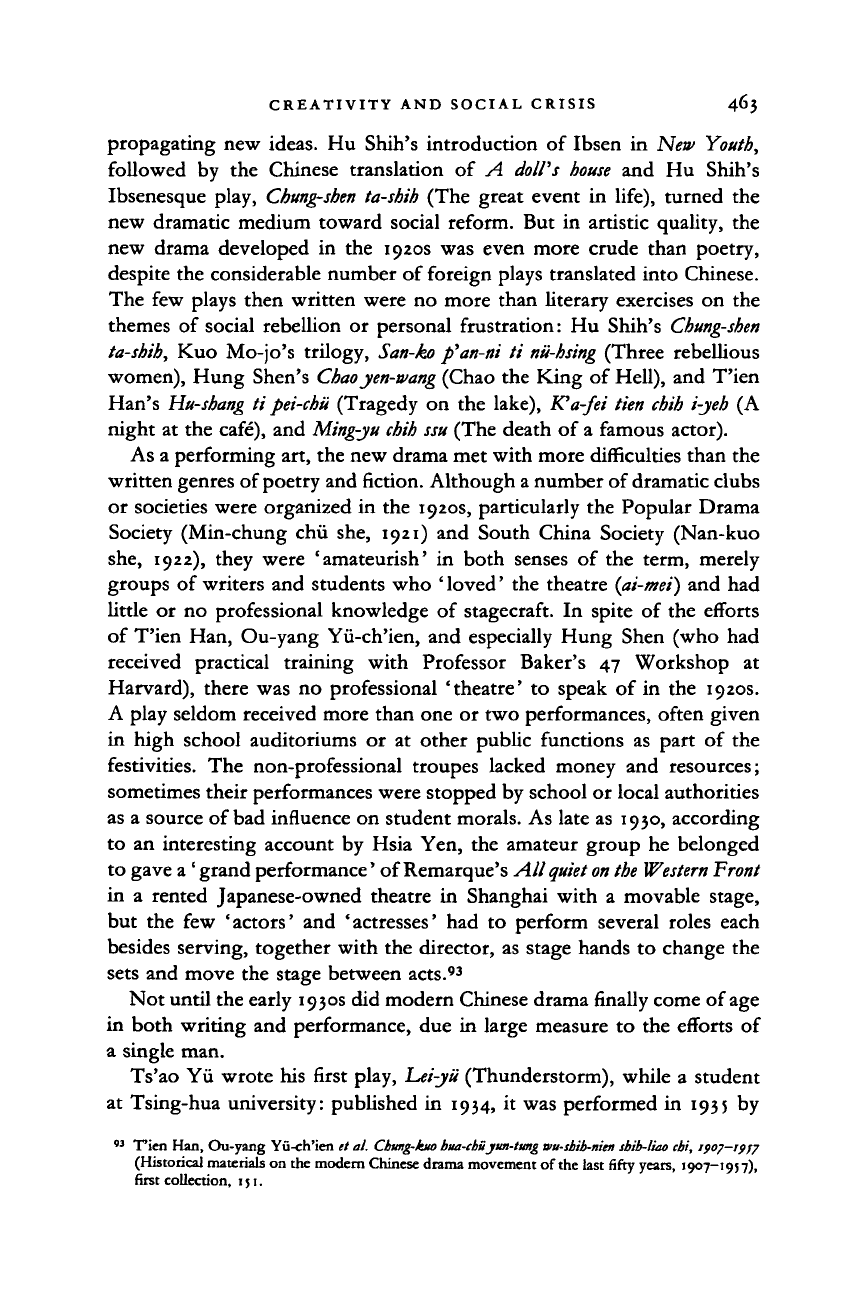
CREATIVITY AND SOCIAL CRISIS 463
propagating new ideas. Hu Shih's introduction of Ibsen in New Youth,
followed by the Chinese translation of A doll's
house
and Hu Shih's
Ibsenesque play,
Chung-sben ta-shih
(The great event in life), turned the
new dramatic medium toward social reform. But in artistic quality, the
new drama developed in the 1920s was even more crude than poetry,
despite the considerable number of foreign plays translated into Chinese.
The few plays then written were no more than literary exercises on the
themes of social rebellion or personal frustration: Hu Shih's
Chung-shen
ta-shih,
Kuo Mo-jo's trilogy,
San-ko
p'an-ni
ti
nu-hsing
(Three rebellious
women), Hung Shen's Chao
yen-wang
(Chao the King of Hell), and T'ien
Han's Hu-shang ti pei-chu (Tragedy on the lake), FCa-fei tien chih
i-yeh
(A
night at the cafe), and
Ming-yu chih ssu
(The death of a famous actor).
As a performing art, the new drama met with more difficulties than the
written genres of poetry and fiction. Although a number of dramatic clubs
or societies were organized in the 1920s, particularly the Popular Drama
Society (Min-chung chii she, 1921) and South China Society (Nan-kuo
she,
1922), they were 'amateurish' in both senses of the term, merely
groups of writers and students who ' loved' the theatre
(ai-mei)
and had
little or no professional knowledge of stagecraft. In spite of the efforts
of T'ien Han, Ou-yang Yii-ch'ien, and especially Hung Shen (who had
received practical training with Professor Baker's 47 Workshop at
Harvard), there was no professional 'theatre' to speak of in the 1920s.
A play seldom received more than one or two performances, often given
in high school auditoriums or at other public functions as part of the
festivities. The non-professional troupes lacked money and resources;
sometimes their performances were stopped by school or local authorities
as a source of bad influence on student morals. As late as 1930, according
to an interesting account by Hsia Yen, the amateur group he belonged
to gave a ' grand performance' of Remarque's
A.II
quiet on the Western Front
in a rented Japanese-owned theatre in Shanghai with a movable stage,
but the few 'actors' and 'actresses' had to perform several roles each
besides serving, together with the director, as stage hands to change the
sets and move the stage between acts.
93
Not until the early 1930s did modern Chinese drama finally come of age
in both writing and performance, due in large measure to the efforts of
a single man.
Ts'ao Yvi wrote his first play, Lei-yii (Thunderstorm), while a student
at Tsing-hua university: published in 1934, it was performed in 1935 by
n
T'ien Han, Ou-yang Yu-ch'ien et al.
Cbung-hu>
bua-cbujun-tung
au-shih-nicn
sbib-liao chi, if 07-19;j
(Historical materials on the modern Chinese drama movement of the last fifty years, 1907-1957),
first collection, IJI.
Cambridge Histories Online © Cambridge University Press, 2008
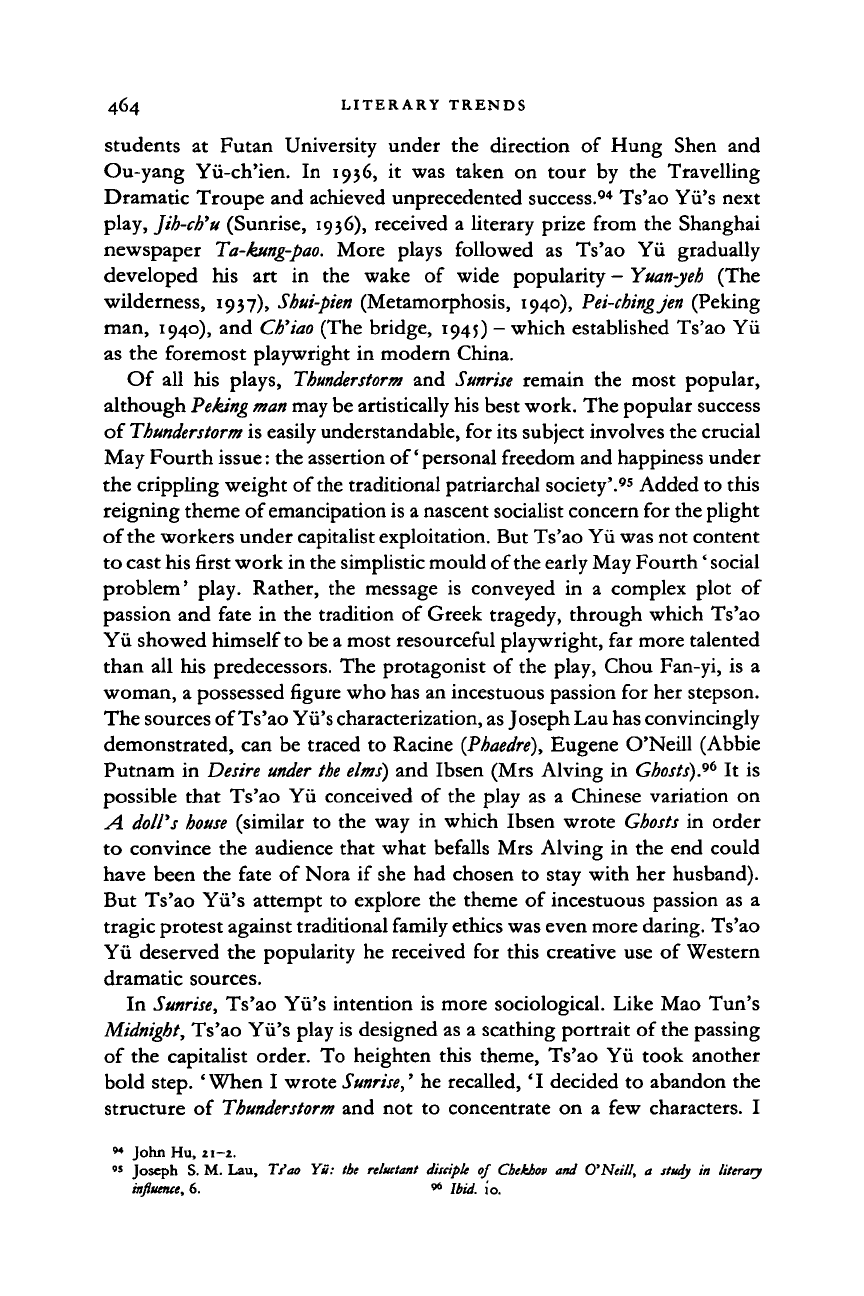
464 LITERARY TRENDS
students at Futan University under the direction of Hung Shen and
Ou-yang Yii-ch'ien. In 1936, it was taken on tour by the Travelling
Dramatic Troupe and achieved unprecedented success.
04
Ts'ao Yii's next
play,
Jih-ch'u
(Sunrise, 1936), received a literary prize from the Shanghai
newspaper
Ta-kung-pao.
More plays followed as Ts'ao Yii gradually
developed his art in the wake of wide popularity -
Yuan-yeh
(The
wilderness, 1937),
Shui-pieti
(Metamorphosis, 1940),
Pei-cbingjen
(Peking
man, 1940), and
Cb'iao
(The bridge, 1945) - which established Ts'ao Yii
as the foremost playwright in modern China.
Of all his plays,
Thunderstorm
and
Sunrise
remain the most popular,
although
Peking man
may be artistically his best work. The popular success
of
Thunderstorm
is easily understandable, for its subject involves the crucial
May Fourth issue: the assertion of'personal freedom and happiness under
the crippling weight of the traditional patriarchal society'.
95
Added to this
reigning theme of emancipation is a nascent socialist concern for the plight
of the workers under capitalist exploitation. But Ts'ao Yii was not content
to cast his first work in the simplistic mould of the early May Fourth' social
problem' play. Rather, the message is conveyed in a complex plot of
passion and fate in the tradition of Greek tragedy, through which Ts'ao
Yii showed himself to be a most resourceful playwright, far more talented
than all his predecessors. The protagonist of the play, Chou Fan-yi, is a
woman, a possessed figure who has an incestuous passion for her stepson.
The sources of Ts'ao Yii's characterization, as Joseph Lau has convincingly
demonstrated, can be traced to Racine
(Phaedre),
Eugene O'Neill (Abbie
Putnam in
Desire under the elms)
and Ibsen (Mrs Alving in
Ghosts).
9
**
It is
possible that Ts'ao Yii conceived of the play as a Chinese variation on
A do/I's
house
(similar to the way in which Ibsen wrote
Ghosts
in order
to convince the audience that what befalls Mrs Alving in the end could
have been the fate of Nora if she had chosen to stay with her husband).
But Ts'ao Yii's attempt to explore the theme of incestuous passion as a
tragic protest against traditional family ethics was even more daring. Ts'ao
Yii deserved the popularity he received for this creative use of Western
dramatic sources.
In
Sunrise,
Ts'ao Yii's intention is more sociological. Like Mao Tun's
Midnight,
Ts'ao Yii's play is designed as a scathing portrait of the passing
of the capitalist order. To heighten this theme, Ts'ao Yii took another
bold step. ' When I wrote
Sunrise,'
he recalled, '
I
decided to abandon the
structure of
Thunderstorm
and not to concentrate on a few characters. I
94
John Hu, 21-2.
55
Joseph S. M. Lau, Ts'ao Yu: the reluctant disciple of Cbekbov and
O'Neill,
a study in literary
influence,
6. *
Ibid.
io.
Cambridge Histories Online © Cambridge University Press, 2008

CREATIVITY AND SOCIAL CRISIS 465
wanted
to use the
fragmentary method
for
Sunrise,
in
which
a
certain
conception is expounded through slices of human life.'
97
The play presents
a cluster
of
characters without any central protagonist.
And to
show
the
contrasting slices of
life,
Ts'ao Yii encompasses in four acts both the upper
and lower
classes.
Act
3,
which takes place in a brothel, invokes a poignant
mood
of
debauchery
and
suffering, perhaps
the
most daringly conceived
dramatic
act in
modern Chinese theatre.
98
One
of the
crucial factors
in
Ts'ao
Yu's
success
was his
acute sense
of drama. He was one
of
the two modern Chinese playwrights (the other
being Hung Shen) who conceived
of
drama
not
only as literature
but
also
as performance.
His
stage directions were elaborately prepared
in
order
to achieve maximum tension.
The
brothel scene
in
Sunrise
is
presented
on
a
split stage with two sets
of
action proceeding simultaneously.
In
The
wilderness,
tom-tom drums and mute visions
are
employed
in the
manner
of O'Neill's Emperor
Jones
to create an atmosphere of psychological horror.
And
the
conscious
use of
Greek tragedy conventions
in
Thunderstorm
is
another example
of
Ts'ao Yii's zealous endeavour
to
master stagecraft.
While clearly imitative
of
Western models
in
technique, Ts'ao Yii's
plays
are
distinctly Chinese
in
content.
His
works dramatized
the
shared
feelings
and
concerns
of his
generation.
The
themes
of his
plays,
exemplified
in
Thunderstorm
and
Sunrise,
are
quite familiar:
the
tragedy
of
the
old
marriage system,
the
feudal family structure,
the
oppression
of
the lower classes,
the
corruption
of
urban capitalists,
and the
frustrations
of young intellectuals.
But
Ts'ao
Yii was
able
to
bring
to
these themes
the shattering force of emotional expression.
In
this he resembled Pa Chin,
whose novel Family
he
adapted into
a
play. Like
Pa
Chin, Ts'ao
Yii was
very much
at the
mercy
of
his emotions. When writing
Thunderstorm,
he
wrote:
'I
was seized with
a
sudden passion
so
overwhelming that
I
could
not
but
seek
to
release
it.' He was
likewise dominated, when writing
Sunrise,
by
'strong emotion from beginning
to
end'.
99
In
fact, most
of
Ts'ao Yii's plays
can be
seen
as
enactments
of
his
own
emotions. They
also betray
the
same defects one finds
in Pa
Chin's novels: undisciplined
style,
over-zealous
use of
hyperbolic language,
and a
tendency toward
melodrama
and
sensationalism.
But as a
dramatist, Ts'ao
Yii had an
obvious advantage over
Pa
Chin
in
being able
to
convey
his
emotional
truth through
a
live medium.
For
all his
sympathies with
the
downtrodden, Ts'ao
Yii was not
narrowly political.
He
was
not
interested
in
using
the
medium which
he
57
Quoted and translated
in
John Hu,
54.
" Because
of
its bold content, this
act was
often omitted
in
performance, much
to
Ts'ao Yii's
chagrin.
*»
Joseph Lau,
6;
John Hu,
24.
Cambridge Histories Online © Cambridge University Press, 2008
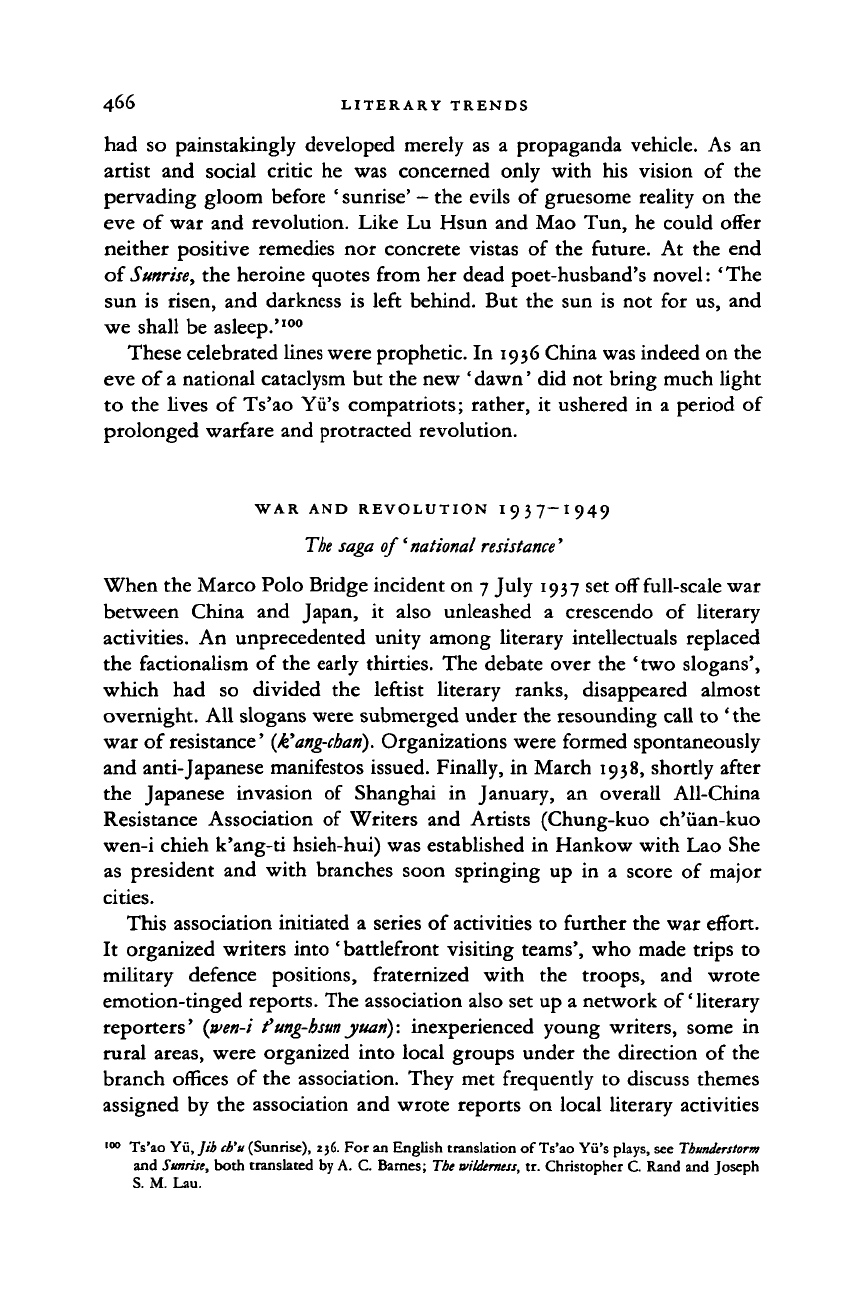
466 LITERARY TRENDS
had so painstakingly developed merely as
a
propaganda vehicle. As an
artist and social critic he was concerned only with his vision
of
the
pervading gloom before ' sunrise'
-
the evils of gruesome reality on the
eve of war and revolution. Like Lu Hsun and Mao Tun, he could offer
neither positive remedies nor concrete vistas of the future. At the end
of
Sunrise,
the heroine quotes from her dead poet-husband's novel: ' The
sun is risen, and darkness is left behind. But the sun is not for us, and
we shall be asleep.'
100
These celebrated lines were prophetic. In 1936 China was indeed on the
eve of a national cataclysm but the new ' dawn' did not bring much light
to the lives of Ts'ao Yii's compatriots; rather, it ushered in a period of
prolonged warfare and protracted revolution.
WAR AND REVOLUTION I937-I949
The saga
of'
national resistance'
When the Marco Polo Bridge incident on 7 July 1937 set off full-scale war
between China and Japan,
it
also unleashed
a
crescendo
of
literary
activities. An unprecedented unity among literary intellectuals replaced
the factionalism of the early thirties. The debate over the ' two slogans',
which had
so
divided the leftist literary ranks, disappeared almost
overnight. All slogans were submerged under the resounding call to 'the
war of resistance'
(k'ang-chan).
Organizations were formed spontaneously
and anti-Japanese manifestos issued. Finally, in March 1938, shortly after
the Japanese invasion
of
Shanghai
in
January,
an
overall All-China
Resistance Association of Writers and Artists (Chung-kuo ch'iian-kuo
wen-i chieh k'ang-ti hsieh-hui) was established in Hankow with Lao She
as president and with branches soon springing up in
a
score of major
cities.
This association initiated a series of activities to further the war effort.
It organized writers into 'battlefront visiting teams', who made trips to
military defence positions, fraternized with
the
troops, and wrote
emotion-tinged reports. The association also set up a network of'literary
reporters' (wen-i f
ung-hsun
yuari):
inexperienced young writers, some in
rural areas, were organized into local groups under the direction of the
branch offices of the association. They met frequently to discuss themes
assigned by the association and wrote reports on local literary activities
100
Ts'ao Yu, Jib cb'u (Sunrise), 236. For an English translation of Ts'ao Yu's plays, see Thunderstorm
and Sunrise, both translated by A. C. Barnes; The
wilderness,
tr. Christopher C. Rand and Joseph
S. M. Lau.
Cambridge Histories Online © Cambridge University Press, 2008
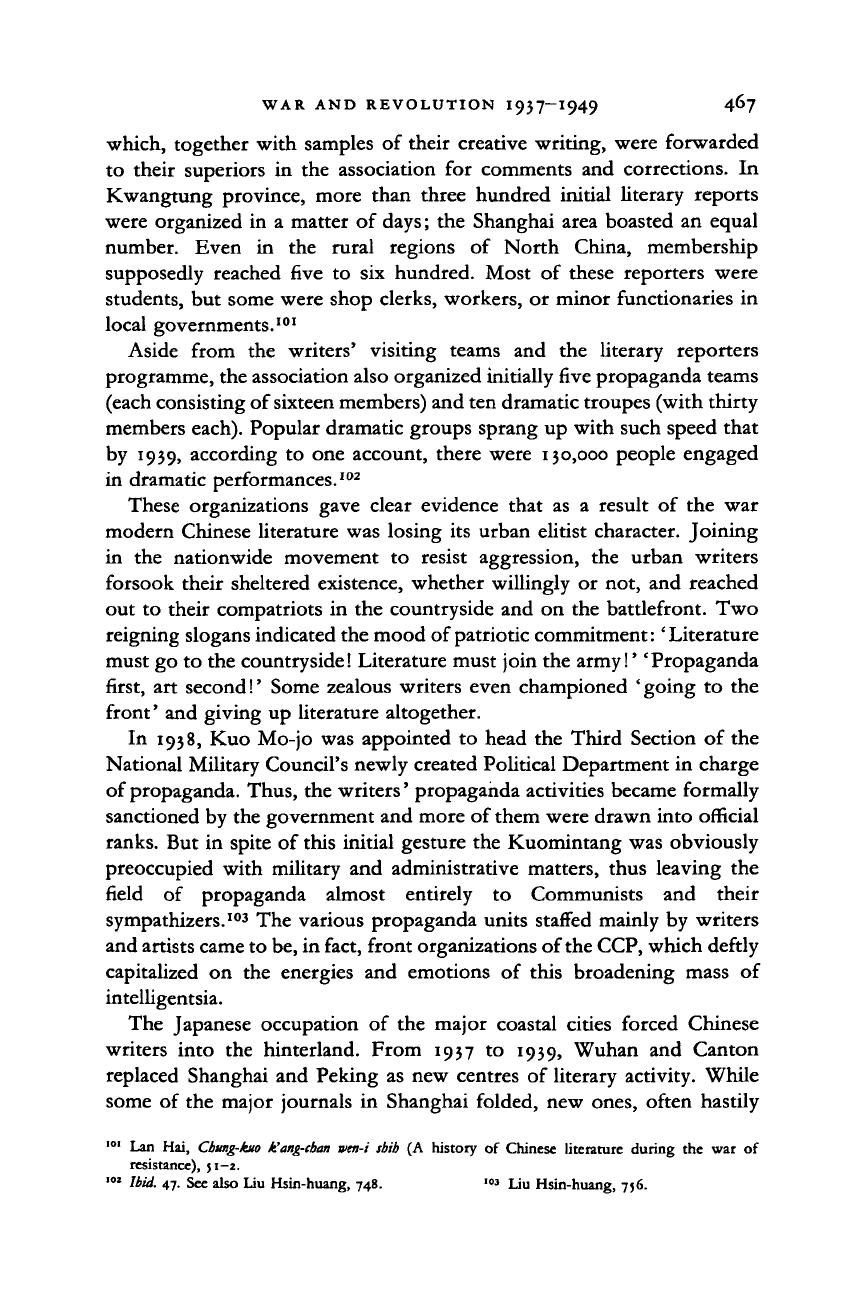
WAR AND REVOLUTION I937-I949 467
which, together with samples of their creative writing, were forwarded
to their superiors in the association for comments and corrections. In
Kwangtung province, more than three hundred initial literary reports
were organized in a matter of days; the Shanghai area boasted an equal
number. Even in the rural regions of North China, membership
supposedly reached five to six hundred. Most of these reporters were
students, but some were shop clerks, workers, or minor functionaries in
local governments.
101
Aside from the writers' visiting teams and the literary reporters
programme, the association also organized initially five propaganda teams
(each consisting of sixteen members) and ten dramatic troupes (with thirty
members each). Popular dramatic groups sprang up with such speed that
by 1939, according to one account, there were 130,000 people engaged
in dramatic performances.
102
These organizations gave clear evidence that as a result of the war
modern Chinese literature was losing its urban elitist character. Joining
in the nationwide movement to resist aggression, the urban writers
forsook their sheltered existence, whether willingly or not, and reached
out to their compatriots in the countryside and on the battlefront. Two
reigning slogans indicated the mood of patriotic commitment:' Literature
must go to the countryside! Literature must join the army!' 'Propaganda
first, art second!' Some zealous writers even championed 'going to the
front' and giving up literature altogether.
In 1938, Kuo Mo-jo was appointed to head the Third Section of the
National Military Council's newly created Political Department in charge
of propaganda. Thus, the writers' propaganda activities became formally
sanctioned by the government and more of them were drawn into official
ranks.
But in spite of this initial gesture the Kuomintang was obviously
preoccupied with military and administrative matters, thus leaving the
field of propaganda almost entirely to Communists and their
sympathizers.
103
The various propaganda units staffed mainly by writers
and artists came to be, in fact, front organizations of the CCP, which deftly
capitalized on the energies and emotions of this broadening mass of
intelligentsia.
The Japanese occupation of the major coastal cities forced Chinese
writers into the hinterland. From 1937 to 1939, Wuhan and Canton
replaced Shanghai and Peking as new centres of literary activity. While
some of the major journals in Shanghai folded, new ones, often hastily
101
Lan Hai, Cbmg-km k'ang-cian wen-i sbib (A history of Chinese literature during the war of
resistance), 51-2.
102
Ibid.
47. See also Liu Hsin-huang, 748.
">
3
Liu Hsin-huang, 756.
Cambridge Histories Online © Cambridge University Press, 2008
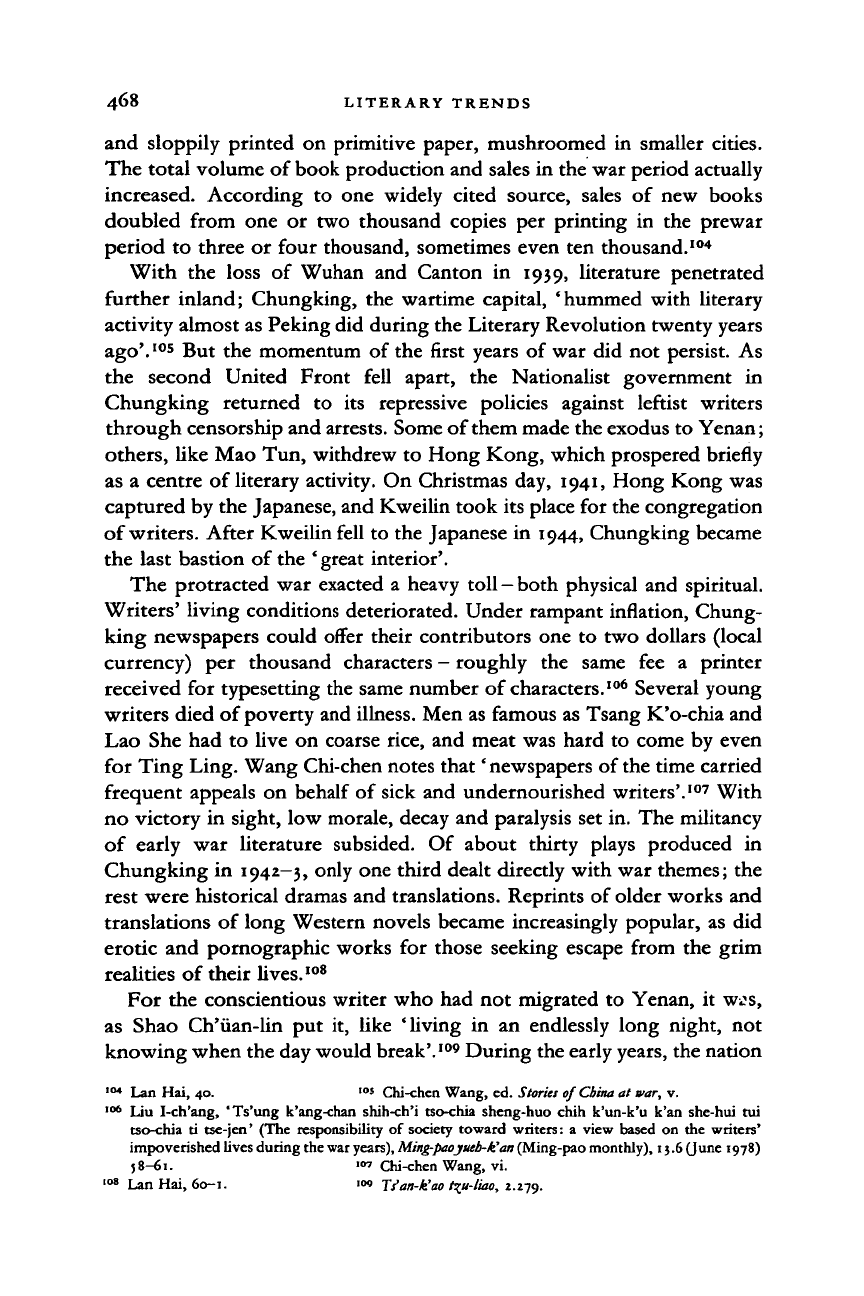
468 LITERARY TRENDS
and sloppily printed on primitive paper, mushroomed in smaller cities.
The total volume of book production and sales in the war period actually
increased. According to one widely cited source, sales of new books
doubled from one or two thousand copies per printing in the prewar
period to three or four thousand, sometimes even ten thousand.
104
With the loss of Wuhan and Canton in 1939, literature penetrated
further inland; Chungking, the wartime capital, 'hummed with literary
activity almost as Peking did during the Literary Revolution twenty years
ago'.
105
But the momentum of the first years of war did not persist. As
the second United Front fell apart, the Nationalist government in
Chungking returned to its repressive policies against leftist writers
through censorship and arrests. Some of them made the exodus to Yenan;
others, like Mao Tun, withdrew to Hong Kong, which prospered briefly
as a centre of literary activity. On Christmas day, 1941, Hong Kong was
captured by the Japanese, and Kweilin took its place for the congregation
of
writers.
After Kweilin fell to the Japanese in 1944, Chungking became
the last bastion of the ' great interior'.
The protracted war exacted a heavy toll —both physical and spiritual.
Writers' living conditions deteriorated. Under rampant inflation, Chung-
king newspapers could offer their contributors one to two dollars (local
currency) per thousand characters - roughly the same fee a printer
received for typesetting the same number of characters.
106
Several young
writers died of poverty and illness. Men as famous as Tsang K'o-chia and
Lao She had to live on coarse rice, and meat was hard to come by even
for Ting Ling. Wang Chi-chen notes that 'newspapers of the time carried
frequent appeals on behalf of sick and undernourished writers'.
107
With
no victory in sight, low morale, decay and paralysis set in. The militancy
of early war literature subsided. Of about thirty plays produced in
Chungking in
1942—3,
only one third dealt directly with war themes; the
rest were historical dramas and translations. Reprints of older works and
translations of long Western novels became increasingly popular, as did
erotic and pornographic works for those seeking escape from the grim
realities of their lives.
108
For the conscientious writer who had not migrated to Yenan, it was,
as Shao Ch'iian-lin put it, like 'living in an endlessly long night, not
knowing when the day would break'.
109
During the early years, the nation
104
Lan Hai, 40.
IOS
Chi-chen Wang,
ed.
Stories
of
China
at
war,
v.
106
Liu
I-ch'ang, "Ts'ung k'ang-chan shih-ch'i tso-chia sheng-huo chin k'un-k'u
k'an
she-hui
tui
tso-chia
ti
tse-jen*
(The
responsibility
of
society toward writers:
a
view based
on the
writers'
impoverished lives during the war years),
Ming-paojueb-fc'an
(Ming-pao monthly), 13.6 (June
1978)
58-61.
I"
Chi-chen Wang,
vi.
108
Lan Hai,
60-1.
•<»
Tfait-k'ao
t^u-liao,
2.279.
Cambridge Histories Online © Cambridge University Press, 2008
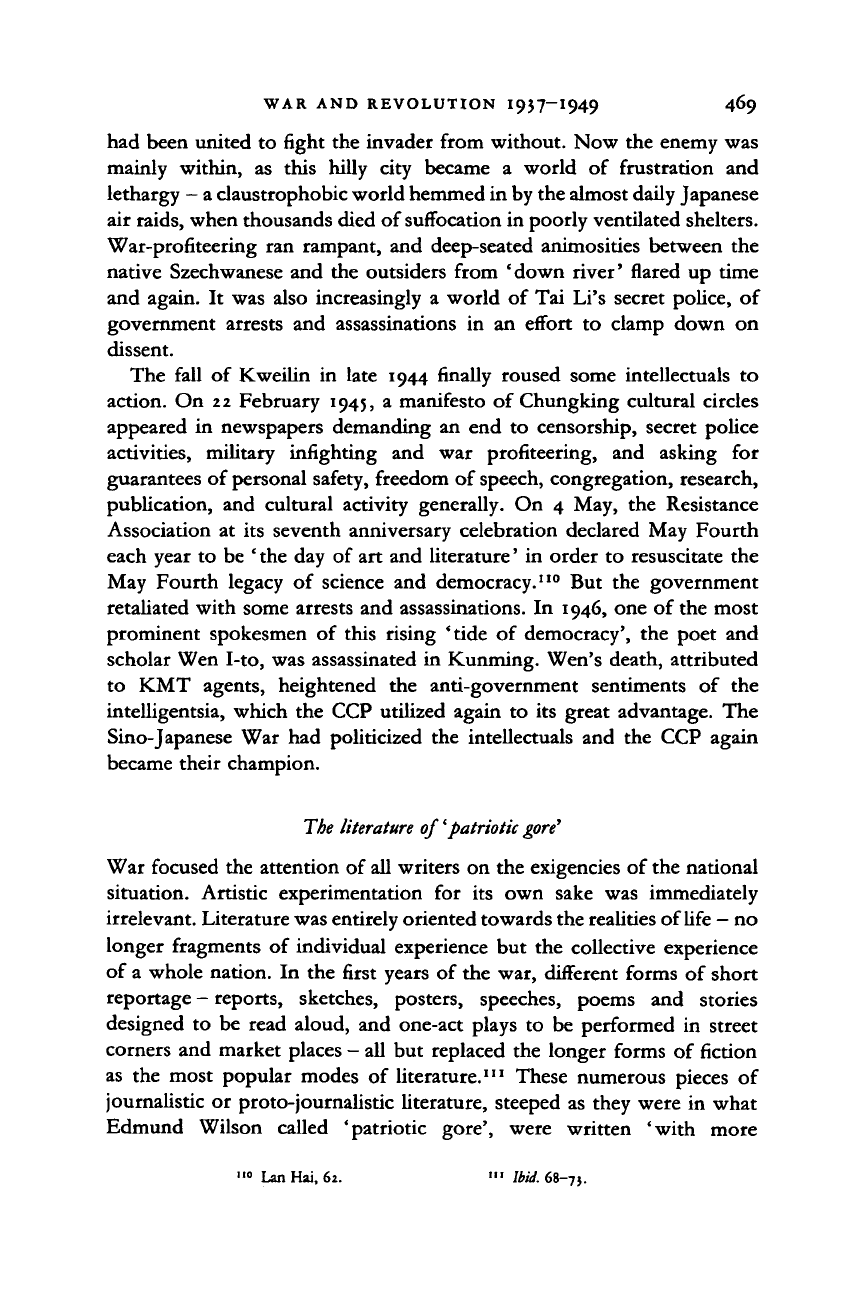
WAR AND REVOLUTION I937-I949 469
had been united to fight the invader from without. Now the enemy was
mainly within, as this hilly city became a world of frustration and
lethargy - a claustrophobic world hemmed in by the almost daily Japanese
air raids, when thousands died of suffocation in poorly ventilated shelters.
War-profiteering ran rampant, and deep-seated animosities between the
native Szechwanese and the outsiders from 'down river' flared up time
and again. It was also increasingly a world of Tai Li's secret police, of
government arrests and assassinations in an effort to clamp down on
dissent.
The fall of Kweilin in late 1944 finally roused some intellectuals to
action. On 22 February 1945, a manifesto of Chungking cultural circles
appeared in newspapers demanding an end to censorship, secret police
activities, military infighting and war profiteering, and asking for
guarantees of personal safety, freedom of speech, congregation, research,
publication, and cultural activity generally. On 4 May, the Resistance
Association at its seventh anniversary celebration declared May Fourth
each year to be '
the
day of art and literature' in order to resuscitate the
May Fourth legacy of science and democracy.
110
But the government
retaliated with some arrests and assassinations. In 1946, one of the most
prominent spokesmen of this rising 'tide of democracy', the poet and
scholar Wen I-to, was assassinated in Kunming. Wen's death, attributed
to KMT agents, heightened the anti-government sentiments of the
intelligentsia, which the CCP utilized again to its great advantage. The
Sino-Japanese War had politicized the intellectuals and the CCP again
became their champion.
Tie literature of 'patriotic
gore'
War focused the attention of all writers on the exigencies of the national
situation. Artistic experimentation for its own sake was immediately
irrelevant. Literature was entirely oriented towards the realities of life - no
longer fragments of individual experience but the collective experience
of a whole nation. In the first years of the war, different forms of short
reportage - reports, sketches, posters, speeches, poems and stories
designed to be read aloud, and one-act plays to be performed in street
corners and market places - all but replaced the longer forms of fiction
as the most popular modes of literature.
1
" These numerous pieces of
journalistic or proto-journalistic literature, steeped as they were in what
Edmund Wilson called 'patriotic gore', were written 'with more
110
Lan Hai, 62. "•
Ibid.
68-73.
Cambridge Histories Online © Cambridge University Press, 2008

47° LITERARY TRENDS
sentiment than artistry; their topical interest and emotional appeal
are
quickly lost when read out
of
context.'
112
While they lacked artistic qualities, they gained immeasurably
in
popularity. Reportage,
in
Chou Yang's view, was
the
'major form
of
national resistance literature', because
it
served most effectively
the
immediate goal of' educating the masses' to the realities of this ' national
self-defensive struggle'.
113
The war had
accelerated
the
process
of
popularization
by
bringing literature, however sloppy
in
quality, away
from the urban ivory tower in Shanghai to the small towns and villages.
This period witnessed the first large-scale effort
of
writers ' going
to
the
people'. In order to appeal to the tastes of the rural populace, the erstwhile
urban writers eagerly resorted
to
the use
of
folk themes, idioms, tunes,
as
well
as
such traditional popular forms as village operas, oral story-telling,
and ta-ku (beating the drum while telling
a
story). Suddenly, the use
of
' old forms' with ' new content' became
a
fad; Lao She was one
of
the
most avid practitioners.
Some writers went
in for
collective authorship.
A
few days after the
Marco Polo Bridge incident, some sixteen dramatists in Shanghai organized
themselves
to
write
a
three-act play,
Pao-wei Lu-kou-ch'iao
(Defend
the
Marco Polo Bridge), which several theatrical troupes competed
to
have
the rights
to
perform even before
it
was finished.
114
Reports
of
writers'
teams visiting the battlefront were sometimes also written collectively.
In an article
of
1939, Hu Feng detected five major weaknesses
of
war
literature: (1)
it
gave merely neat propaganda formulas; (2)
it
tended
to
present
all the
trivial details without, however, attaining any depth
of
vision, thus losing rather than gaining a sense of reality; (3) in some cases
it gave fantastic twists
to
real stories;
(4) due to
these defects,
war
literature had not produced either great heroic epics
or
works
of
vivid
realism; (5) 'intellectual poverty'
in
turn begot artistic poverty, and the
task
of
popularizing literature was yet
to
achieve success.
115
Hu Feng's
criticism obviously showed his dissatisfaction with the lowering of artistic
standards. Together with Mao Tun,
he
was opposed
to
the excessively
politicized view that wartime literature should only depict the 'healthy'
and ' bright' side
of
life.
A
critic
of
integrity should call upon writers,
as Mao Tun put it, not only
to
portray ' the new brightness' but also
to
expose aspects of'new darkness'.
116
Some critics in Chungking, however,
opposed the erosion of literary quality by propaganda and argued, on the
112
Julia
Lin, 171.
"
3
TSan-k'ao t^u-liao, 1.631,
638.
"+
Lan Hai, 43.
">
Hu
Feng, Min-tsu cban-cbengju atn-i bsing-ko
(The
national
war and the
character
of
literature),
53—5.
"*
Tfiw-k'ao
t^u-liao,
1.670-1.
Cambridge Histories Online © Cambridge University Press, 2008
